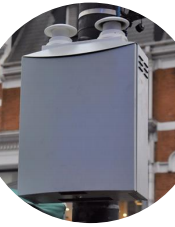Air quality is measured across the UK at many locations. Locally we have a network of sites across Oxfordshire. More detailed information can be found on the homepage.
There are a number of ways to measure what is in air. The three main ways to measure pollutants which we will look at are:
Automatic Monitoring
Automatic monitoring is the most sophisticated method of monitoring air pollution, but is also the most expensive! There are 7 sites across Oxfordshire that use automatic monitoring techniques.
- Automatic sites operate 24 hours a day, continuously measuring pollutants
- Automatic monitoring sites calculate the concentration of the chosen pollutant by pulling ambient air through the analyser via the inlet
- Different analysers are used to measure each pollutant. For example a site may have 3 analysers; 1 measuring NOx, 1 measuring ozone and 1 measuring particles (such as PM10)
- The data from the site is collected by a computer which means the concentrations can be seen virtually in real time from the site or when the data is collected
Non-automatic Monitoring - Passive Monitoring
Passive monitoring is normally a simple and inexpensive monitoring technique to measure gas concentrations using diffusion tubes. It does not require electricity or the use of pumps like the automatic monitoring method.
- Diffusion tubes are small plastic tubes with a single cap at the top when exposed. You might have seen some strapped to some lampposts!
- Diffusion tubes normally monitor for 2-4 weeks at a time
- Under the cap at the top is a mesh disc which is coated with a chemical that absorbs NO2. The bottom cap is removed when sampling to allow air to flow inside the tube then is closed and sent for analysis after the exposure period
- When gases pass over the mesh, the compound inside the tube changes
- The tubes must be sent to a laboratory for analysis to see how much NO2 has been absorbed
- Non-automatic monitoring methods are lower cost than automatic monitoring methods but are generally less accurate and the averaging periods are greater therefore day to day trends cannot be observed
Sensors
Air quality sensors are simple, small and low power devices. They can provide data every minute.  Oxford Friends of the Earth have distributed sensors across the city and are using them for screening to identify pollution hot spots. Find out more information on the Oxford Particulates Monitoring Project.
Oxford Friends of the Earth have distributed sensors across the city and are using them for screening to identify pollution hot spots. Find out more information on the Oxford Particulates Monitoring Project.
- They are useful for quickly finding out were air pollution is high
- But data collected must be checked against established methods such as automatic monitoring sites to ensure a ‘true’ reading is being taken

